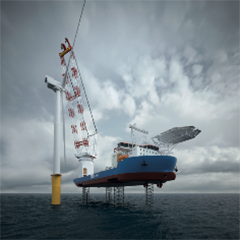The past decade has been a period of large evolutionary steps for offshore wind and the upcoming years are set to continue this trend, further establishing wind power as a maturing player in the global energy mix. As economy of scale is driving up the size of turbines and wind farms, the offshore units used to install and maintain these offshore farms are evolving as well.
The step-up in capacity of these units opens up possibilities to incorporate another dynamic, cleaner and evolving player in the energy mix; LNG or Liquefied Natural Gas, which is gaining traction as a fuel for various sectors of the offshore and maritime industry.
These industries are experiencing increasingly stricter global and local emission limits, mainly due to a continuing rise in environmental awareness and subsequent political initiatives. The most recent and perhaps far-reaching example of this is the global Sulphur cap of 0.5% on marine fuels, set to come into effect in 2020. Hence, lowering emissions, fuel consumption and the overall growth of alternative power generation is a prominent maritime development.
Offshore wind farm installation and maintenance operations offer favourable conditions for the use of LNG. This is due to the relatively high predictability of the operational profile and proximity of shore bases and deep sea ports, facilitating cost-effective LNG supply which minimises the design impact on offshore wind farm installation and maintenance units.



























